Starting an online clothing business is exciting. You’ve got the creative freedom to design your own collections, build a unique identity, and reach customers from all over the world. But let’s be honest, it’s also overwhelming.
With thousands of fashion brands popping up every day, just having good-looking clothes or a sleek website is no longer enough. The real challenge? Getting people to notice you, trust you, and keep coming back.
That’s where digital marketing becomes your secret weapon.
It’s not just about running ads or posting on Instagram. Digital marketing, when done right, helps you build a loyal community, drive consistent website traffic, tell a memorable brand story, and turn casual visitors into repeat buyers.
This blog is your step-by-step guide to mastering that. Whether you’re just starting out with your first drop or looking to scale up and hit 6-figure sales, these 10 digital marketing strategies will help your brand stand out in a crowded market, and grow in a way that feels authentic, strategic, and fun.
Let’s dive in.
1. Build a Brand That Feels Like a Vibe
People don’t just buy clothes, they buy how it makes them feel.
So, what’s your story? Are you a minimalist brand? Size-inclusive? Vintage-inspired? Sustainable? Let that story shine everywhere, from your logo and packaging to your Instagram captions.
Pro Tip: Your “About Us” page isn’t just a formality. It’s where people connect with your mission. Make it personal.
2. Own Your Social Media Game
Let’s face it, if you’re in fashion and not showing up on social media, do you even exist?
Here’s how to make it work:
- Instagram: Show off your outfits, post Reels, run giveaways
- Pinterest: Create mood boards and seasonal lookbooks
- TikTok: Trendy hauls, styling tips, behind-the-scenes
- Facebook & WhatsApp: Still golden for older audiences and regional buyers
Don’t forget those “Shop Now” buttons, turn scrolls into sales.
3. Team Up with Influencers & Encourage UGC
People trust people. Period.
- Collaborate with micro-influencers (they have crazy loyal audiences)
- Encourage your happy customers to post pics and tag you
- Repost those tagged stories, instant social proof!
Run a hashtag campaign like #MyStyleWith[YourBrand] and maybe offer discounts to top contributors. Win-win!
4. Get Found with Google: SEO Matters
Here’s the thing, people are searching right now for things like:
- “Boho cotton dresses under $40”
- “Summer co-ord sets for vacation”
If your site doesn’t pop up? You’re invisible.
So:
- Use the right keywords in your product titles and descriptions
- Add blogs to your site like “5 Ways to Style Linen Pants”
- Don’t skip alt text on your images, it helps with Google AND accessibility
Trust me, organic traffic is gold. And free.
5. Slide into Their Inbox (And Their Texts)
Social media is great, but email and SMS? That’s direct access.
Use it to:
- Share new arrivals, styling ideas, or special drops
- Remind people of their abandoned carts (yep, those still work)
- Offer exclusive deals or early access to loyal buyers
Build a list from day one. Your email list is yours. Algorithms can’t mess with it.
6. Make Your Website the Star of the Show
Think of your website as your online flagship store, it needs to look good AND work well.
- Make it fast, mobile-friendly, and easy to browse
- Use crisp, styled photos and maybe even short videos
- Add filters, size guides, and reviews
- Include “Wear it with” or “You may also like” sections to keep people scrolling
Bonus points if you add live chat or WhatsApp for quick questions and styling help.
7. Run Paid Ads, but Smartly
Don’t just boost posts randomly. Set a goal, choose your audience, test creatives.
Start with:
- Instagram & Facebook Ads (great for visuals + targeting)
- Google Shopping Ads (show up directly in search results)
- Retargeting Ads (those “Hey, you forgot something” ones)
A small budget with smart targeting can go a long way.
8. Use the Power of Short Videos
People love snackable content. Use Reels, TikTok, or YouTube Shorts to show:
- Outfit transformations
- Styling hacks
- BTS of photoshoots or packaging
- Real people wearing your clothes
And yes, use trending audio. It actually helps with reach!
9. Stand for Something (It Really Works)
Fashion is personal, and values matter more than ever.
- Are your clothes eco-friendly? Show your process.
- Are you promoting body positivity? Let your models reflect that.
- Are you supporting local artisans? Tell us their stories.
People don’t just want pretty clothes, they want to feel good about where they shop.
10. Track, Learn, Repeat
Don’t just guess what’s working, measure it.
Use tools like:
- Google Analytics to track where traffic is coming from
- Shopify or WooCommerce reports to see your bestsellers
- Heatmaps to find what people are clicking on
Test everything: different product photos, button colors, even subject lines. Small tweaks = big results.
Bonus Tip: Lean into Seasons & Events
Fashion changes with the seasons, so your marketing should too.
Plan campaigns around:
- Festivals (Diwali, Christmas, Eid, etc.)
- Weather (“Monsoon-friendly fashion”)
- Events (Weddings, Vacations, Back to School)
Create curated collections or limited drops to create FOMO.
Conclusion
The fashion industry is ever-evolving, but one thing remains constant: people want to feel something when they shop. They’re not just looking for the next trendy outfit, they’re looking for a brand that gets them, reflects their values, and offers a seamless, delightful experience from first scroll to checkout.
That’s where digital marketing plays a massive role. It’s how you connect, communicate, and convert. From building an unforgettable brand story to mastering short-form video, from tapping into influencers to making your website shoppable and sleek, each strategy adds a layer to your brand’s digital presence.
And the best part? You don’t have to do everything all at once. Start where you are. Pick 2 or 3 strategies that make the most sense for your current stage and build from there. Test, tweak, learn, and evolve. Digital marketing isn’t one-size-fits-all, it’s your playground to experiment and grow.
So whether you’re building a conscious fashion label, a streetwear brand, or a luxury ethnic wear line, one thing is certain: when you combine a great product with smart digital strategies, you’re not just building a store, you’re building a brand that lasts.
Your future customers are out there. Let’s go get them.
FAQs
1. What are the best marketing strategies for clothing brands?
The best marketing strategies for clothing brands combine creativity, consistency, and customer connection. Here’s what works:
- Strong branding: Have a clear identity: logo, color palette, tone, and brand story.
- Social media marketing: Showcase collections, run styling tips, Reels, and behind-the-scenes.
- Influencer partnerships: Collaborate with creators who align with your brand vibe.
- Email & SMS marketing: Great for launches, promotions, and re-engaging loyal customers.
- Content marketing: Blogs, videos, and lookbooks help you connect beyond products.
- SEO optimization: Helps you rank when people search for specific outfits or styles.
- Paid ads: Smart Facebook, Instagram, and Google ads boost visibility and conversions.
It’s all about mixing storytelling with strategy to keep your audience excited and engaged.
2. What are the top 7 types of digital marketing strategies?
Here are the top 7 digital marketing strategies every brand, clothing or not, should know:
- Content Marketing – Blogs, videos, guides, and lookbooks that provide value and build trust.
- Social Media Marketing – Organic and paid content on Instagram, Facebook, Pinterest, TikTok, etc.
- Search Engine Optimization (SEO) – Optimizing content and site to rank higher on Google.
- Email Marketing – Personalized emails for promotions, new arrivals, and cart recovery.
- Pay-Per-Click Advertising (PPC) – Google Ads, Meta Ads, and other paid campaigns.
- Influencer Marketing – Partnering with creators to reach their engaged audiences.
- Affiliate Marketing – Letting affiliates promote your brand in return for a commission.
When used together, these strategies create a powerful ecosystem for digital growth.
3. How to digital market a clothing brand?
Marketing a clothing brand digitally involves a mix of creativity, data, and consistency. Here’s a simple roadmap:
- Build a user-friendly website with quality images, size guides, and easy checkout.
- Leverage social media—especially Instagram, Pinterest, and TikTok, for showcasing collections and UGC.
- Run Facebook/Instagram ads to reach your target audience.
- Optimize your site for SEO so customers can find you organically.
- Use email marketing to announce drops, flash sales, and nurture your community.
- Work with influencers or brand ambassadors to build trust and reach.
- Track analytics to see what works and tweak your strategy accordingly.
Start small, stay consistent, and scale what works.
4. What is Zara’s digital marketing strategy?
Zara’s digital marketing strategy is all about speed, customer data, and minimalist elegance.
- Fast Fashion Model: Zara quickly turns runway trends into affordable styles, getting them to market in just a few weeks.
- Minimalist digital campaigns: Instead of loud promotions, Zara focuses on high-fashion visuals and clean storytelling.
- Social media presence: They use Instagram aesthetically, focusing on curated visuals and lifestyle shots.
- Mobile-first and app marketing: Zara pushes app downloads and personalizes shopping experiences.
- Data-driven decisions: Zara uses real-time customer feedback from stores and online to inform collections and restocks.
Zara doesn’t chase attention, they create intrigue and exclusivity, which keeps people coming back.
5. What strategy does Zara use?
Zara uses a differentiated strategy called “fast fashion.” Here’s what that means:
- Speed to market: Designs are created, produced, and distributed in a matter of weeks.
- Limited stock model: This creates scarcity and urgency, encouraging quick purchases.
- Customer-centric: Zara listens closely to feedback and adapts collections fast.
- In-house production: Unlike most retailers, Zara controls most of its supply chain for agility.
- Low marketing spend: They spend less on ads and more on prime store locations and trendsetting designs.
The essence of Zara’s strategy? Be fast, be relevant, and always listen to the customer.
6. What are the 4 P’s of fashion marketing?
The 4 P’s of fashion marketing are the pillars that help build and market a clothing brand successfully:
- Product – The actual clothing: design, fabric, quality, and style. In fashion, uniqueness and appeal are key.
- Price – How much your product costs. It should reflect your brand’s positioning: luxury, budget-friendly, sustainable, etc.
- Place – Where and how you sell: online store, pop-ups, Instagram Shop, or multi-brand marketplaces.
- Promotion – How you attract customers: ads, influencer campaigns, social media, PR, etc.
Fashion marketing is about balancing all four to create a seamless customer journey from discovery to checkout.











